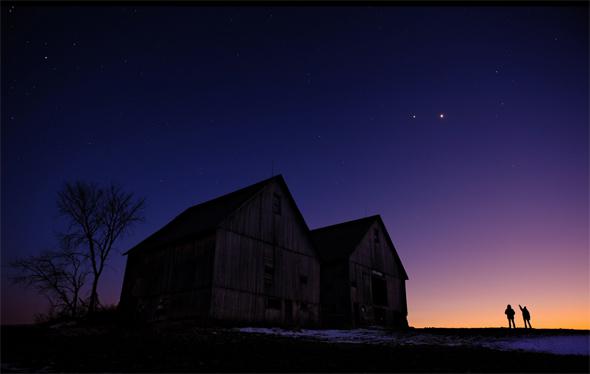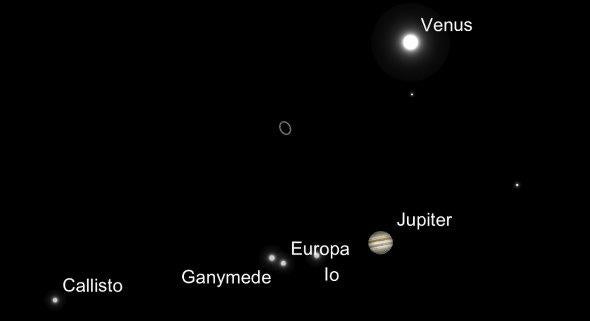There’s a real treat in the sky over the next few nights: Venus and Jupiter will be very close together. How close?
Very, very close. Closest approach (what astronomers call the appulse, but is more colloquially and commonly called a conjunction) will be on Saturday at 22:00 UTC (18:00 Eastern U.S. time), and at that time they’ll be an incredible four arcminutes apart. That’s only one-seventh the width of the full Moon on the sky!* In fact Jupiter appears half an arc minute across, so Venus will only be about eight times Jupiter’s diameter away!
That’s close. Close enough that they’ll barely be far enough apart to separate by eye. The simulated shot at the top of this post shows the view through a telescope at closest approach; you can see Jupiter, its moons, and Venus all together nice and snug.
Now for the not so great news: The two are only a little over 20° from the Sun, so they’ll be low over the western horizon by the time the sky gets dark after sunset. The good news though is that both are so bright they’re visible even while the sky is still bright, especially in binoculars. If you know where to look you can actually see them when the Sun is up, too! But that’s for folks with some experience; do NOT search for them with binoculars; the Sun is so bright it can physically hurt your eyes if you accidentally glimpse it through them.

Guillaume Poulin, used by permission
The conjunction is cool not just because it’s pretty (and it is). It’s also rare. The planets orbit the Sun, moving at different speeds. They all stay in pretty much the same plane—it’s usually called the plane of the solar system—and we’re in it too, so the planets move more or less along the same path in the sky. But not exactly the same path, so they pass each other at various distances. A close pass is pretty rare and in fact this is the closest any two planets get all year.
It’s also cool because of the physical reality of what you’re seeing. Venus orbits the Sun closer than Earth, and it’s on the other side of the Sun right now. So you’re looking past the Sun (which is 150 million kilometers away from us) to Venus, which is about 230 million kilometers away. Jupiter is a staggering 950 million kilometers away!
What amazes me is that even though Jupiter is more than four times farther away, it still appears three times bigger than Venus. That’s because Jupiter is ridiculously huge, a dozen times the diameter of Venus.
And one other thing. I’ve written about Juno, the spacecraft currently in orbit around Jupiter. It currently takes 53.5 days to go around Jupiter once and is screaming back toward Jupiter right now. On Saturday, the same day as the conjunction, Juno reaches perijove, its closest approach to Jupiter—just 4,000 kilometers above the cloudtops! After that it heads back out, moving away from the giant planet once again. In October, it’ll fire its engine and lower the orbit, moving it into its science orbit.
My friend Emily Lakdawalla at the Planetary Society has written about Juno many times, and describes an amazing video showing Jupiter as seen from the spacecraft as it moved away from Jupiter nearly two months ago. Here’s the video, but go read Emily’s write-up, because (as usual) it’s great.
I love how Jupiter is half full, a view we don’t get from Earth.
But our view this weekend (and really for several days) of Jupiter will be amazing, and that’s a pretty good consolation prize. I hope you have clear skies and an unrestricted view of this wonderful event.
Correction, Aug. 26, 2016: I originally misstated that the separation was one-fifteenth the width of the Moon, but the Moon is 0.5 degrees (or 30 arcminutes) across. Thirty divided by four is roughly 7.
